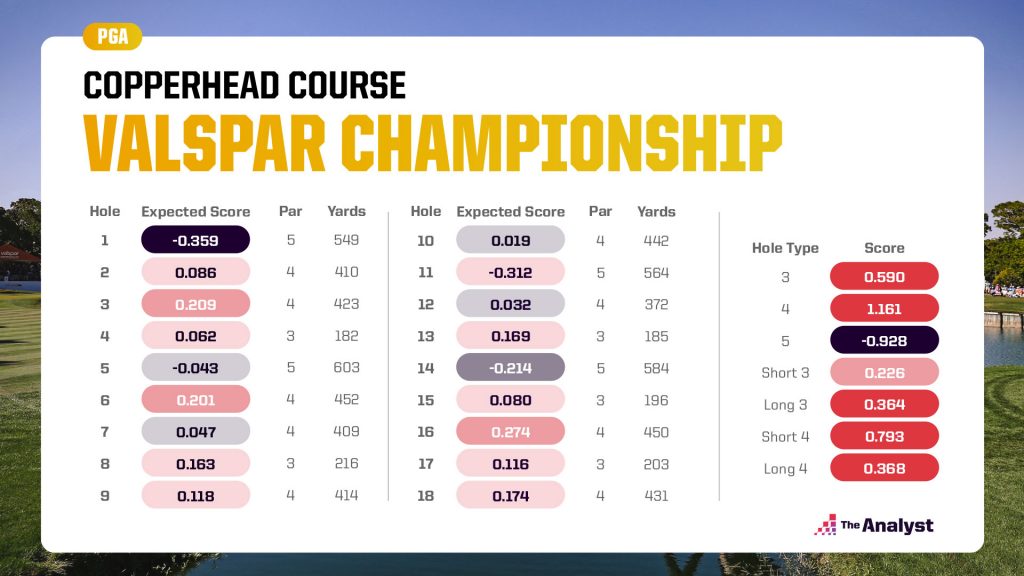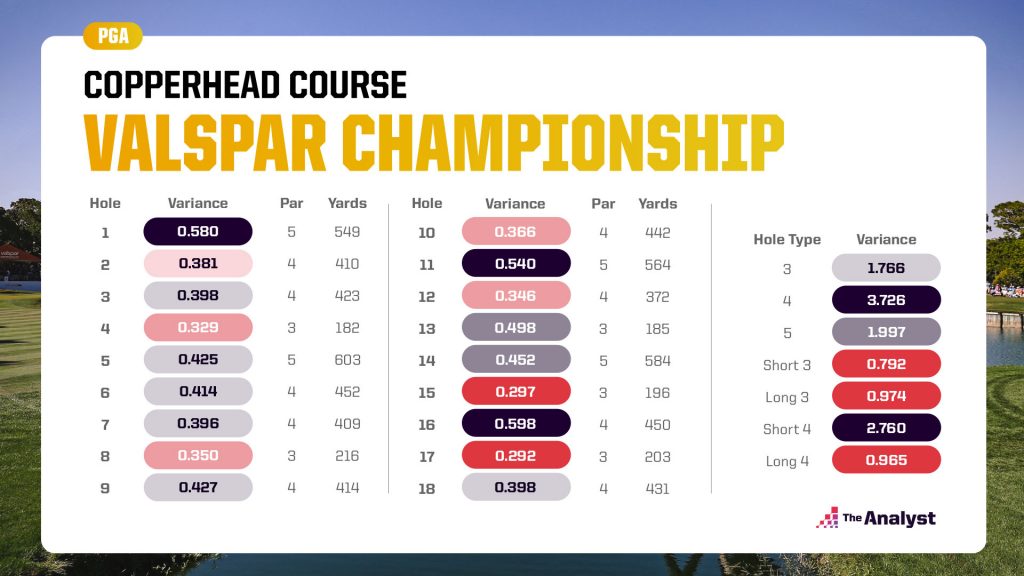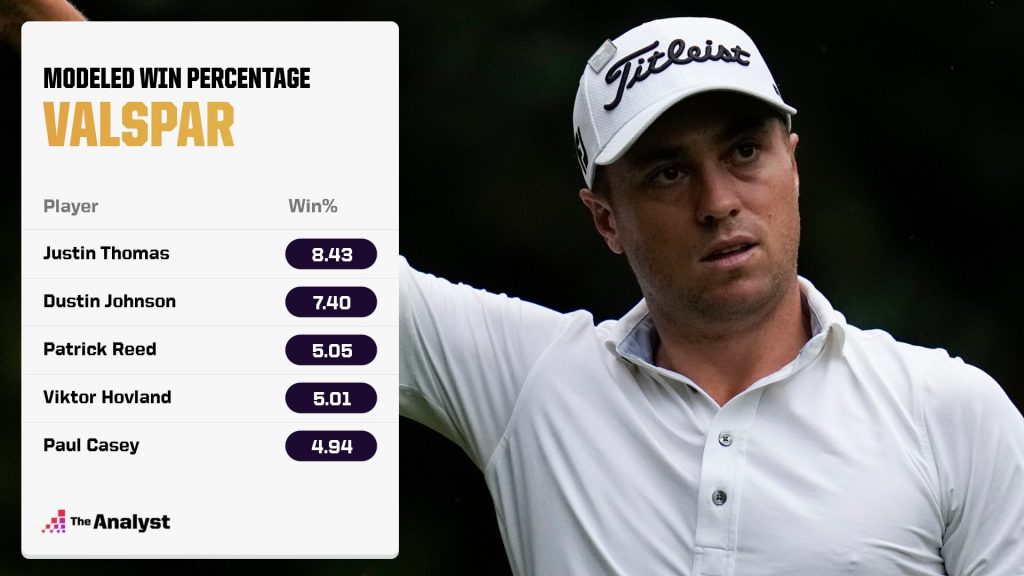Scoring is tough at Copperhead.
Despite a lack of long holes, the course features narrow fairways lined by bunkers, tiny greens, and nine holes with water in play.
After a week off of stroke play for the PGA, the tour welcomes back the Valspar Championship, hosted by Innisbrook Resort and played on the challenging Copperhead Golf Course. The Valspar was a COVID casualty in 2020, which means Paul Casey remains the reigning two-time champion of the event. Casey won with a score of 8-under in 2019 and 10-under in 2018.
Though not historically a strong-field event, the Valspar was moved back a few weeks in the schedule this season, which has attracted a strong contingency of tour regulars to the field. While FRACAS rates this week’s field as below tour average, that is due in large part to the enormous turnout of 156 golfers. If we take the top 100 golfers scheduled to play, we have a field that’s about 0.42 strokes per round above tour average. For comparison, that’s only slightly weaker than the RBC Heritage and considerably stronger than the Texas Open.
Copperhead is a difficult par 71 that can play up to 7,340 yards. For the Valspar, the course setup has traditionally been closer to 7,080 yards. Most of the yardage comes off of the par 3s, which are set up to play about 15 yards shorter than their listed yardages. However, with the stronger field, it would be unsurprising if the course setup this week is closer to the whiteline yardages. Unlike most par 71s, Copperhead features five par 3s and four par 5s, sacrificing two par 4s. It makes par 4 scoring a little less valuable than a typical tournament, particularly when looking at the long par 4s. In fact, there are no par 4s over 460 yards.
One would think that the previously mentioned trouble would make the course play wildly variably, but that’s not true in the case of Copperhead. The total variance of the course is just 7.49 strokes, one of the lowest on heavily used tour courses. The trouble on the course almost dictates the players’ golf shots. There are a lot of forced layups and not a lot of holes that present a true risk-reward. Players who can put the ball in play and minimize damage have the most success, and putting is minimized some by the green size.


The FRACAS Picks
As we discuss every week, there is a difference between who we think will win, and who we think is a good value relative to the market. We’ll start with the former before getting into our favorite value picks.
Justin Thomas is our pick to win this week at 8.43%. When we first ran the model, we were a little surprised by how large that number is. When we dug into it more, we found that the increased size of field combined with the low variability of the course really props up the best players. Why is that? Because making the cut is paramount and with low course variability, the best players don’t have too many opportunities to lose a ton of strokes to the field on a single hole.
Both Thomas and Dustin Johnson are projected to make the cut more than 80% of the time, while just 32 other golfers have more than a 60% chance to make the cut. With a huge field, the model is recognizing that the strength of the field after the cut is likely to be weaker when a handful of poor golfers make the cut after two good rounds. With JT’s high chance to make the cut, it is likely he will play the weekend against a weaker field than most tournaments, giving him a better chance to win.
So the size of the field at 156 golfers will naturally whittle down the strength of the weekend field, which gives the best players who make the cut a better chance at winning.

The FRACAS Value Plays
It’s another board we don’t love, but there are a couple of favorites who are undervalued this week as well as a triple-digit golfer who stands a fighting chance.
We’re a fan of Casey as well this week, but the odds reflect his status as a two-time winner at this course and we don’t see much value on him in the market. Instead, we’ll look at South African Louis Oosthuizen, who is coming off a playoff loss in the team event to Team Australia. Oosthuizen doesn’t have hole-specific weaknesses. He’s projected to gain strokes on the field on every hole type and should be able to take advantage of the par 5s, where he is projected to score sixth lowest in the field. To top it off, Oosty has a second, 16th and seventh-place finish in his last three trips to Copperhead. His odds can be found at around 28-1, but we also think that might slip a bit and catching him above 30-1 is a strong possibility. Our model puts him around 25-1 – a decent value that gets better if his odds slide at all.
Further down the board, we see a great value on Max Homa. Homa has a history of success at difficult golf courses, including a win at Riviera this year. He’s a wizard on par 5s and is projected to perform fourth best in the field on the par 5s at Copperhead. He’s no slouch on other hole types either and is one of only 10 players in the field who is projected to gain 0.05 strokes per hole or more on every hole type this week. He can currently be found at 66-1, but he’s another golfer whose odds could slip a little, providing more value for our projected odds of 48-1.
Another longer-odds American with a history of winning is Lanto Griffin. While we give him just a 1.5% chance to win this weekend, Copperhead is a course that should suit Griffin well. That’s because he performs exceptionally on long par 3s and is projected to gain strokes on the field on every other hole type as well. Griffin has not played this tournament in any of the last occurrences, but with a course designed to dictate your golf shots and that has angles predetermined for you, being a course rookie shouldn’t be an issue. The strength of field he traditionally enters averages about 529, and with the Valspar projecting for only 418, we find him undervalued. Our model puts his projection at 66-1, and he can be found in the 90s.
Our lone triple-digit odds golfer this week is a familiar one: Mackenzie Hughes. While fellow Canadian Corey Conners has been understandably garnering all the attention lately, Hughes has eight top 10s in his last 32 tournaments. While his odds are hovering around 100-1, we have him projected to about 77-1, which does provide some value. It’s a fantastic course fit for Hughes, who performs poorly on longer par 4s and well above average on all other hole types. FRACAS’ course adjustment gives him the fourth-highest course adjustment in the field and the highest among golfers who have any meaningful chance at winning.
DraftKings GPP Value Plays
Our model also simulates DraftKings results. This is an important distinction, as DraftKings points are driven both by finishing position and hole scoring, so players like Tony Finau who make a lot of birdies while also making some bogeys may be better DraftKings plays than players like Charles Howell III, who has a great chance to make the cut but doesn’t score much.
We’ll go through each salary grouping and identify players we see as being underpriced relative to value and those players who are around them. Generally we’ll identify around 20 players we like, though that number can change depending on the size of the field.
$9,400+
Losing Tyrrell Hatton (COVID-19) at $9,500 made this range a little tighter on the wallet. Thomas and Johnson have our highest points per dollar projections, but it’s darned tough to fit them into a lineup while not losing significant value with lower-priced golfers. We’ll start most of our lineups with one of Patrick Reed, Casey, and/or Oosthuizen.
- Justin Thomas $11,500
- Dustin Johnson $11,200
- Patrick Reed $10,300
- Paul Casey $10,000
- Louis Oosthuizen $9,500
$8,000+
This range will see heavy, heavy usage in our lineups this week. The dropoff from here is steep when it comes to cut equity, and this is an excellent place to fill three spots in your lineup without using a ton of salary. Along with Reed, Casey, and Oosthuizen, over a third of our lineup builds will include Justin Rose, Jason Kokrak, Ryan Palmer, and Homa.
- Justin Rose $8,800
- Jason Kokrak $8,700
- Ryan Palmer $8,500
- Max Homa $8,100
- Talor Gooch $8,000
- Kevin Na $8,000
Everyone Else
This is the salary group for our dart throws. After getting a solid core with the above picks, it’s this group where we’re hoping to find some cheaper options with a good chance of making the cut.
The one exception in this range is Rasmus Hojgaard, a 20-year-old Danish golfer who plays most of his golf on the European Tour. Hojgaard and Phil Mickelson are the two golfers we’ve selected who project to have less than a 50% chance to make the cut. The reason he’s on this list is his potential. When thinking about taking down a GPP, we’re looking for golfers who can finish in the top 10, and Hojgaard has the talent to make that happen. He could absolutely shoot 16-over par in two rounds, but the data also suggests that he can go out and finish in the top 5.
Of the 17 golfers right above Hojgaard in projected cut percentage, only one of them has a higher chance of finishing in the top 5. If you’re playing a 50/50 lineup, probably best to avoid Hojgaard. Gary Woodland, Griffin, and Hojgaard are our highest value plays in this group.
- Gary Woodland $7,800
- Kevin Streelman $7,800
- Kevin Kisner $7,700
- Erik Van Rooyen $7,600
- Adam Hadwin $7,600
- Cameron Davis $7,500
- Lanto Griffin $7,400
- Mackenzie Hughes $7,400
- Ian Poulter $7,400
- Alex Noren $7,300
- J.T. Poston $7,200
- Zach Johnson $7,200
- Danny Willett $7,200
- Phil Mickelson $7,200
- Rasmus Hojgaard $7,000
- Tom Hoge $7,000
- Luke List $7,000
- Wyndham Clark $6,900
Design by Matt Sisneros.
